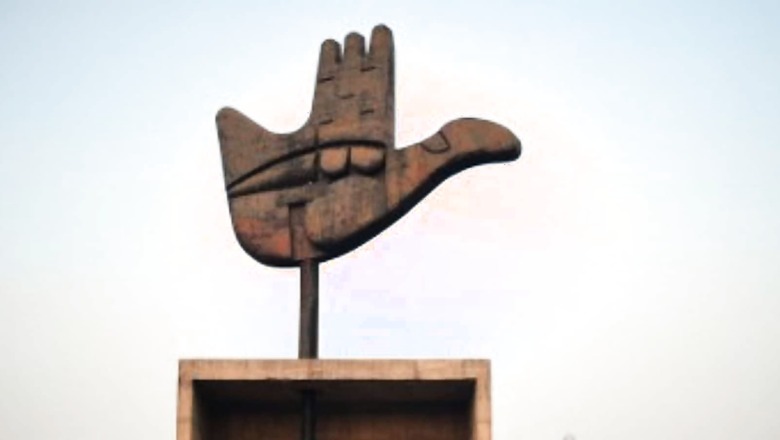
views
Punjab and Haryana are suddenly locked into a battle over their capital Chandigarh. The Haryana government on Tuesday unanimously passed a resolution, noting with concern the resolution recently passed by the Punjab assembly staking claim over the union territory.
Like in Punjab, in Haryana, too, the ruling and opposition parties have come together to support the resolution. Khattar has raised concerns over the Aam Aadmi Party-led Punjab government’s sudden move to stake a claim on the joint capital. He has also said before moving such a resolution, Punjab CM Bhagwant Mann should have taken all stakeholders in the matter into confidence.
This is not the first time Punjab has staked a claim over Chandigarh. Such resolutions have been passed at least seven times in the past, mostly by Akali Dal-led governments. But, a latest move by the ministry of home affairs to announce central service rules for UT employees has once again renewed Punjab’s resentment over its dwindling share in the UT administration.
Why is Punjab staking a claim once again?
Chief minister Bhagwant Mann immediately moved to pass a resolution, urging the Centre to transfer Chandigarh to Punjab, soon after union home minister Amit Shah announced that central service rules will apply to UT employees. Earlier, UT employees were governed by the state service rules of Punjab. Shah’s announcement had led to a political row, when he said the change in service rules will benefit UT administration employees in a “big way”.
What does the latest Haryana resolution say?
Khattar said a three-hour discussion was held on the resolution. The Haryana CM brought up issues of the construction of the Sutlej Yamuna Link canal and the transfer of Hindi-speaking areas to the state. He also raised the issue of the Bhakra Beas Management Board (BBMB) and posting of Haryana officials in Chandigarh UT. While raising the SYL canal issue, Khattar urged the Centre to take measures for its construction. The resolution read, “This House notes with concern the resolution passed in the Legislative Assembly of Punjab on 1 April, 2022 recommending that the matter for transfer of Chandigarh to Punjab be taken up with the Central government. This is not acceptable to the people of Haryana. Haryana continues to retain its right to the capital territory of Chandigarh.”
What does the latest Punjab resolution say?
Passed on April 1, the resolution passed by the Punjab assembly seeks immediate transfer of Chandigarh to the state. According to the resolution, Haryana was carved out of Punjab in 1966 and, whenever a state has been divided in the past, the capital remains with the parent state.
“Punjab, therefore, has been laying its claim for complete transfer of Chandigarh to Punjab,” the resolution stated. “For maintaining harmony and taking the sentiments of people into account, this House once again recommends to the state government to raise the matter with central government to immediately transfer Chandigarh to Punjab,” it said. During the discussion for the resolution, MLAs raised issues of the three repealed farm laws and appointment of members on the BBMB. They also discussed sharing of river waters.
In his address, Mann underlined the “apathetic and step motherly” treatment meted out to Punjab. “I want to give a guarantee to the people of Punjab that we will strongly fight and protect state’s rights, be it in the Vidhan Sabha or Parliament or on any other platform,” he had said.
The composition of the UT administration
In the wake of Shah’s announcement, it is important to take into account the composition of the Chandigarh administration. Since its creation as the joint capital and the reorganisation of the two states, it has always been managed by officers of Punjab and Haryana in the ratio of 60:40. The resolution claimed that a balance has been maintained in the administration of common assets like the BBMB.
Why was Chandigarh created?
Originally, Chandigarh was planned to replace Lahore that was the capital of Punjab before the Partition. Lahore became a part of Pakistan during the Partition. So, in consultation with the Centre, the then state government in Punjab approved the area of the foothills of the Shivaliks as a site for a new capital in March 1948. The then Prime Minister Jawaharlal Nehru wanted an organised city that symbolised free India’s march ahead, wanting it to be a model for the rest of the world. So, in consultation with Swiss-French architect Le Corbusier, Chandigarh was conceptualised. Its construction began in the early 1950s and most of it was completed in the early 1960s. Before Haryana was carved out in 1966, Chandigarh remained the capital of Punjab from 1952.
How did it become a shared capital?
When Punjab was reorganised in 1966 and Haryana was carved out of it, both states laid a claim to the UT. The division of the state was done on a linguistic basis of Punjabi-speaking Punjab and Hindi-speaking Haryana. Some territories also went to Himachal Pradesh. The city then assumed the unique distinction of being the joint capital, a temporary solution by Indira Gandhi to resolve the immediate dispute.
Gandhi declared it a UT and the city’s administration was placed directly under the control of the Centre. But, it still continued to function more in favour of Punjab with the 60:40 division of properties. In 1976, however, the Centre had to extend the UT’s status as joint capital as Punjab and Haryana were adamant about staking a claim.
Then comes the Rajiv-Longowal accord of 1985, which was signed by the then PM Rajiv Gandhi and Akali Dal chief Harchand Singh Longowal. According to the accord, Chandigarh should have been handed over to Punjab in 1986 while so-called Hindi-speaking cities like Abohar and Fazilka were to go to Haryana. But, Longowal was assassinated by Sikh militants due to which the accord could never be ratified, and the Rajiv Gandhi-led Centre withdrew at the last minute. The dispute continued well into the mid-1990s due to militancy and Punjab’s reluctance to part with its so-called Hindi-speaking areas.
Read all the Latest Politics News and Breaking News here




















Comments
0 comment